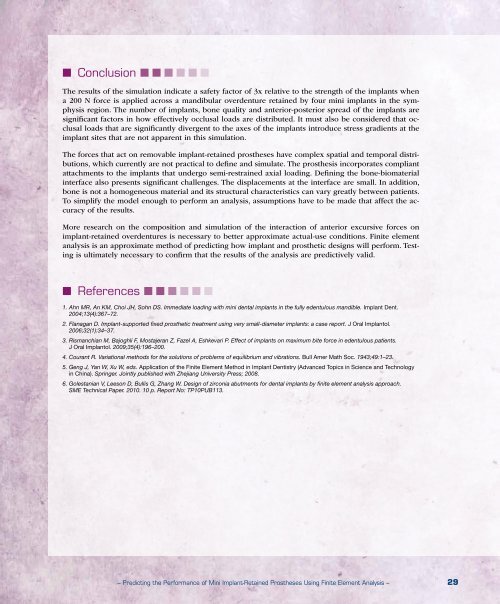Inclusive - Glidewell Dental Labs
Inclusive - Glidewell Dental Labs
Inclusive - Glidewell Dental Labs
You also want an ePaper? Increase the reach of your titles
YUMPU automatically turns print PDFs into web optimized ePapers that Google loves.
n Conclusion n n n n n n<br />
The results of the simulation indicate a safety factor of 3x relative to the strength of the implants when<br />
a 200 N force is applied across a mandibular overdenture retained by four mini implants in the symphysis<br />
region. The number of implants, bone quality and anterior-posterior spread of the implants are<br />
significant factors in how effectively occlusal loads are distributed. It must also be considered that occlusal<br />
loads that are significantly divergent to the axes of the implants introduce stress gradients at the<br />
implant sites that are not apparent in this simulation.<br />
The forces that act on removable implant-retained prostheses have complex spatial and temporal distributions,<br />
which currently are not practical to define and simulate. The prosthesis incorporates compliant<br />
attachments to the implants that undergo semi-restrained axial loading. Defining the bone-biomaterial<br />
interface also presents significant challenges. The displacements at the interface are small. In addition,<br />
bone is not a homogeneous material and its structural characteristics can vary greatly between patients.<br />
To simplify the model enough to perform an analysis, assumptions have to be made that affect the accuracy<br />
of the results.<br />
More research on the composition and simulation of the interaction of anterior excursive forces on<br />
implant-retained overdentures is necessary to better approximate actual-use conditions. Finite element<br />
analysis is an approximate method of predicting how implant and prosthetic designs will perform. Testing<br />
is ultimately necessary to confirm that the results of the analysis are predictively valid.<br />
n References n n n n n n<br />
1. Ahn MR, An KM, Choi JH, Sohn DS. Immediate loading with mini dental implants in the fully edentulous mandible. Implant Dent.<br />
2004;13(4):367–72.<br />
2. Flanagan D. Implant-supported fixed prosthetic treatment using very small-diameter implants: a case report. J Oral Implantol.<br />
2006;32(1):34–37.<br />
3. Rismanchian M, Bajoghli F, Mostajeran Z, Fazel A, Eshkevari P. Effect of implants on maximum bite force in edentulous patients.<br />
J Oral Implantol. 2009;35(4):196–200.<br />
4. Courant R. Variational methods for the solutions of problems of equilibrium and vibrations. Bull Amer Math Soc. 1943;49:1–23.<br />
5. Geng J, Yan W, Xu W, eds. Application of the Finite Element Method in Implant Dentistry (Advanced Topics in Science and Technology<br />
in China). Springer. Jointly published with Zhejiang University Press; 2008.<br />
6. Golestanian V, Leeson D, Bullis G, Zhang W. Design of zirconia abutments for dental implants by finite element analysis approach.<br />
SME Technical Paper. 2010. 10 p. Report No: TP10PUB113.<br />
– Predicting the Performance of Mini Implant-Retained Prostheses Using Finite Element Analysis – 29

















